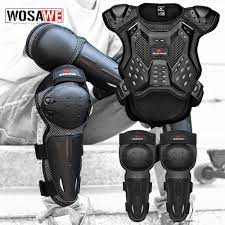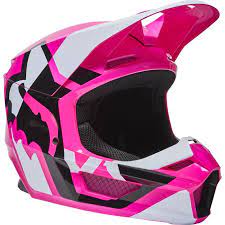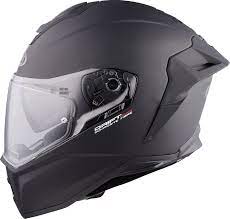
Motorcycle Safety Gear: Protecting Yourself on Two Wheels
Riding a motorcycle is an exhilarating experience that offers a sense of freedom and adventure like no other. However, it’s important to remember that with this thrill comes a greater risk compared to driving a car. That’s why investing in proper motorcycle safety gear is essential for every rider.
Helmets are perhaps the most crucial piece of safety equipment for any motorcyclist. They protect your head from potential injuries and can be the difference between life and death in the event of an accident. When choosing a helmet, opt for one that meets or exceeds safety standards, such as the DOT (Department of Transportation) or ECE (Economic Commission for Europe) certification. Additionally, make sure it fits correctly and snugly on your head to provide maximum protection.
Protective clothing is another vital aspect of motorcycle safety gear. Abrasion-resistant jackets, pants, and gloves can significantly reduce the risk of road rash in case of a fall or slide. Look for garments made from high-quality materials like leather or textile with built-in armor at key impact areas such as shoulders, elbows, back, hips, and knees. These armored pieces offer additional protection without compromising comfort or mobility.
Footwear specifically designed for motorcycling is also crucial. Sturdy boots with ankle support not only protect your feet from impact but also provide better grip and control while riding. Avoid wearing open-toed shoes or sandals as they offer minimal protection in case of an accident.
Eye protection is often overlooked but equally important. A good pair of goggles or a visor shield protects your eyes from wind, debris, insects, and harmful UV rays. They also enhance visibility by reducing glare and improving contrast during different weather conditions.
Lastly, don’t forget about reflective gear to increase your visibility on the road. Reflective vests or strips attached to your clothing can make you more noticeable to other drivers during low-light situations, such as at dusk or night.
Remember, motorcycle safety gear is not just a fashion statement – it’s a matter of personal safety. By investing in the right equipment and wearing it every time you ride, you significantly reduce the risk of serious injuries or even fatalities.
It’s also essential to regularly inspect your safety gear for any signs of wear and tear. Replace any damaged or worn-out items promptly to ensure they provide optimal protection when you need it most.
In conclusion, riding a motorcycle comes with inherent risks, but by wearing proper safety gear, you can significantly mitigate those risks. From helmets and protective clothing to footwear and eye protection, each piece plays a vital role in safeguarding your well-being on the road. So before you hop on your bike for your next adventure, make sure you’re properly geared up for the ride ahead. Stay safe and enjoy the thrill of motorcycling responsibly!
Essential Motorcycle Safety Gear Tips for UK Riders
- Wear a full-face helmet
- Wear protective clothing
- Wear gloves
- Invest in sturdy boots
- Use reflective gear at night
Wear a full-face helmet
Wear a Full-Face Helmet: Protecting Your Head and Face on the Road
When it comes to motorcycle safety gear, one tip that cannot be emphasized enough is wearing a full-face helmet. Your head is one of the most vulnerable areas in case of an accident, and a full-face helmet provides the best protection for both your skull and face.
A full-face helmet covers your entire head, including your chin and face. This means that not only does it shield you from potential impact injuries, but it also safeguards your eyes, nose, and mouth from debris, wind, insects, and other hazards you may encounter while riding.
The benefits of wearing a full-face helmet are numerous. Firstly, it significantly reduces the risk of traumatic brain injuries in case of a crash. The hard outer shell absorbs impact forces and distributes them across the helmet’s surface, minimizing the direct force on your head.
Secondly, a full-face helmet offers superior protection against facial injuries. The chin bar protects your jawline and lower face from serious damage in case of an accident. It acts as a barrier between your face and any potential objects or surfaces that could cause harm.
Additionally, wearing a full-face helmet helps to reduce distractions caused by wind noise. The built-in visor or shield not only protects your eyes from wind-induced tears but also reduces noise levels during high-speed rides. This allows you to focus more on the road ahead without being distracted by excessive wind turbulence.
Furthermore, a full-face helmet provides better insulation against weather elements such as rain or cold temperatures. It keeps you dry during wet rides and shields your face from chilly winds, ensuring comfort throughout your journey.
When selecting a full-face helmet, ensure that it meets safety standards such as DOT (Department of Transportation) or ECE (Economic Commission for Europe) certification. Additionally, consider factors like proper fitment and ventilation to ensure maximum comfort during long rides.
Remember that wearing a full-face helmet should be a non-negotiable part of your motorcycle gear. It’s not just about following the law; it’s about prioritizing your safety and well-being on the road. By protecting your head and face, you significantly reduce the risk of severe injuries that could have lifelong consequences.
So, before you hop on your motorcycle for your next adventure, make sure to wear a full-face helmet. It’s a small investment that can make a world of difference in keeping you safe and allowing you to fully enjoy the thrill of riding while having peace of mind. Ride responsibly and protect yourself – your head deserves it!
Wear protective clothing
Wear Protective Clothing: Your Shield on Two Wheels
When it comes to riding a motorcycle, safety should always be a top priority. One of the most important aspects of motorcycle safety gear is protective clothing. It acts as your shield, providing a crucial layer of defense against potential injuries.
Motorcycle-specific jackets, pants, and gloves are designed with durability and protection in mind. These garments are often made from abrasion-resistant materials like leather or textile, which can significantly reduce the risk of road rash in case of an accident. They act as a barrier between your skin and the harsh pavement, minimizing the impact on your body.
In addition to their sturdy construction, many motorcycle jackets and pants come equipped with built-in armor at key impact areas such as shoulders, elbows, back, hips, and knees. This armor absorbs and distributes the force of an impact, reducing the likelihood of fractures or other serious injuries.
Gloves are equally important when it comes to protecting your hands. They not only shield your skin from abrasions but also provide better grip and control while riding. Look for gloves that offer reinforced palms and knuckle protection for added safety.
It’s essential to wear this protective clothing every time you ride – even for short trips. Accidents can happen unexpectedly, and it’s better to be prepared than regret not wearing proper gear later.
Remember that protective clothing is not just about safety; it can also enhance your comfort while riding. Many motorcycle jackets and pants feature ventilation systems that allow air circulation to keep you cool during hot weather conditions. Additionally, waterproof or windproof options ensure you stay dry and warm in adverse weather conditions.
Investing in high-quality protective clothing may seem like an additional expense, but it is a small price to pay for your safety on the road. Remember to choose gear that fits properly – not too loose or too tight – to ensure maximum protection without compromising mobility.
So before you hop on your motorcycle, make sure you’re wearing the right protective clothing. It’s your shield against potential injuries and a crucial step towards responsible riding. Stay safe, enjoy the open road, and embrace the adventure with confidence!
Wear gloves
Wear Gloves: Protecting Your Hands on the Road
When it comes to motorcycle safety gear, one item that often gets overlooked but is incredibly important is a good pair of gloves. Your hands are not only essential for controlling your bike, but they are also vulnerable in the event of an accident. That’s why wearing gloves should be a non-negotiable part of your riding gear.
Gloves serve multiple purposes when it comes to motorcycle safety. Firstly, they provide protection against abrasions and cuts in case of a fall or slide. The palms and fingers are particularly susceptible to injury during an accident, so having a layer of protective material between your skin and the road can make a significant difference.
Secondly, gloves offer better grip and control on the handlebars. They help reduce vibrations from the bike’s engine, which can cause discomfort or numbness during long rides. With proper grip, you’ll have more precise control over throttle, brakes, and clutch, enhancing your overall riding experience.
Moreover, gloves act as a barrier against weather elements such as wind, rain, or extreme temperatures. They keep your hands warm in cold weather and prevent them from becoming sweaty or slippery during hot summer rides. This added comfort allows you to stay focused on the road without distractions caused by discomfort.
When choosing motorcycle gloves, consider factors like material and fit. Leather gloves are popular for their durability and excellent abrasion resistance. Textile gloves with reinforced areas can also provide adequate protection while offering increased flexibility and breathability.
Ensure that your gloves fit snugly but not too tight to restrict movement or blood circulation. Look for options with adjustable closures around the wrist area to ensure a secure fit that doesn’t let them slip off in case of an accident.
Remember that not all gloves are created equal in terms of protection levels. Look for gloves specifically designed for motorcycle use and check if they meet safety standards such as CE certification.
In conclusion, wearing gloves is a simple yet crucial step in ensuring your safety on the road. They protect your hands from potential injuries, improve grip and control, and enhance overall comfort during your rides. So, before you start your engine and embark on your next adventure, don’t forget to slip on a pair of gloves – your hands will thank you for it. Stay safe and enjoy the ride!
Invest in sturdy boots
Investing in Sturdy Boots: A Step Towards Motorcycle Safety
When it comes to motorcycle safety gear, one item that often gets overlooked is footwear. However, wearing the right boots can make a significant difference in protecting your feet and enhancing your overall riding experience.
Motorcycle boots are specifically designed to provide the necessary support and protection while riding. They offer ankle stability, which is crucial for maintaining control over your bike, especially during sudden stops or maneuvers. Unlike regular shoes or sneakers, sturdy motorcycle boots have reinforced soles that provide better grip on the footpegs and prevent slipping.
One of the primary benefits of wearing motorcycle boots is their ability to protect your feet from potential injuries in case of an accident. Motorcycle accidents can be unpredictable, and having proper footwear can significantly reduce the risk of fractures, sprains, or other foot-related injuries. The reinforced toe caps and heel cups found in these boots act as a protective shield against impact.
Moreover, motorcycle boots are designed with abrasion-resistant materials such as leather or synthetic textiles. This feature becomes crucial during slides or falls as they help minimize road rash by providing a layer of protection between your skin and the road surface.
Comfort is another aspect to consider when investing in sturdy motorcycle boots. Long rides can take a toll on your feet, but with well-designed boots that offer proper cushioning and support, you can enjoy extended periods of riding without discomfort or fatigue.
Additionally, many motorcycle boots come with features like waterproofing or ventilation systems that keep your feet dry and comfortable in various weather conditions. This ensures that you remain focused on the road ahead without distractions caused by wet or sweaty feet.
Remember that not all boots are created equal when it comes to motorcycling. Look for those specifically designed for riders with features like ankle protection, reinforced soles, and quality construction. Consider trying them on before purchasing to ensure a proper fit that offers both comfort and functionality.
In conclusion, investing in sturdy motorcycle boots is a wise decision for any rider concerned about safety. They provide essential protection, support, and comfort for your feet while riding. By making this small investment, you take a significant step towards enhancing your safety on the road. So, before you embark on your next motorcycle adventure, make sure to gear up with a pair of reliable and sturdy boots. Your feet will thank you for it!
Use reflective gear at night
Enhance Your Visibility: Use Reflective Gear for Nighttime Motorcycle Safety
When it comes to motorcycle safety gear, one tip that should never be overlooked is the use of reflective gear, especially when riding at night. As the sun sets and visibility decreases, being seen by other drivers becomes even more critical.
Reflective gear acts as a powerful tool to make you more visible on the road. It works by reflecting light back to its source, whether it’s headlights from oncoming vehicles or streetlights. This increased visibility can make a significant difference in preventing accidents and ensuring your safety.
One of the simplest ways to incorporate reflective gear into your riding attire is by wearing a reflective vest or jacket. These garments are designed with strategically placed reflective strips or panels that catch and reflect light, making you easily noticeable from a distance. Not only does this help drivers spot you sooner, but it also allows them to gauge your position and speed accurately.
If you prefer not to wear an additional layer of clothing, consider attaching adhesive reflective strips to your helmet, motorcycle jacket, or even your bike itself. These strips are highly effective at capturing attention and can be easily applied and removed as needed.
Another option is investing in motorcycle gear that comes with built-in reflective elements. Many manufacturers now offer helmets, jackets, pants, and even gloves with integrated reflective materials. This way, you don’t have to worry about adding extra accessories or compromising style for safety.
Remember that using reflective gear is not limited to just clothing; it extends to accessories as well. Reflective stickers on your motorcycle’s bodywork or wheels can significantly increase your visibility from various angles. Additionally, consider using reflectors on your boots or attaching them to your backpack or saddlebags for added visibility.
While relying on other drivers’ attentiveness is important, taking proactive steps to enhance your own visibility is equally crucial. By incorporating reflective gear into your nighttime riding routine, you become a more visible and predictable presence on the road, reducing the chances of accidents caused by lack of awareness.
So, whether you’re embarking on a night ride or simply commuting during low-light conditions, don’t forget to wear or incorporate reflective gear. It’s a small investment that can make a significant difference in your safety. Stay visible, stay safe, and enjoy your nighttime rides with confidence!



